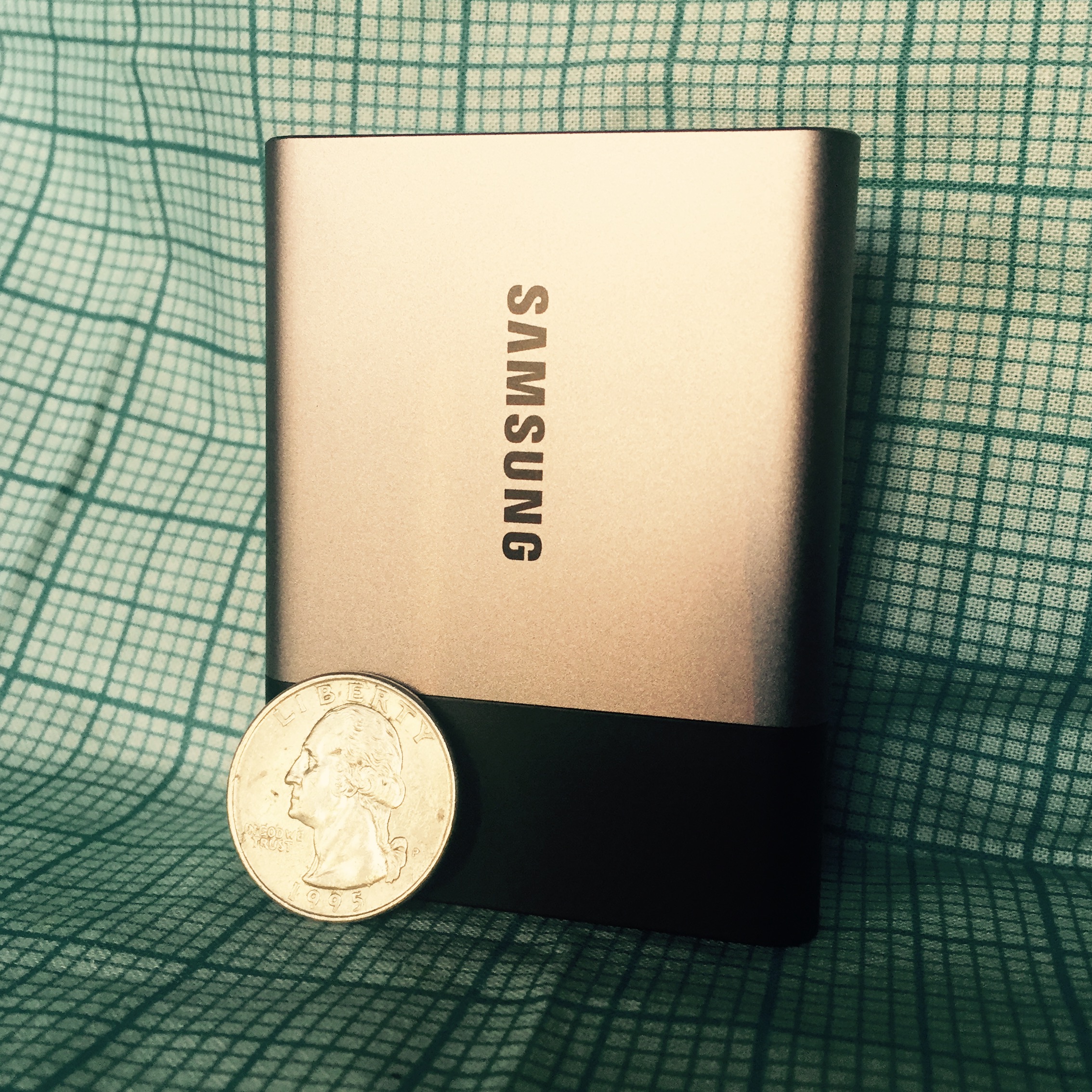-
Some backstory: I’ve never regretted a purchasing decision more than not springing for a bigger SSD on my Macbook Pro. 128GB is borderline enough for software dev, but not nearly enough when recording a podcast. It’s a constant dance of deleting increasingly esoteric things via CleanMyMac, and wiping XCode derived data folders. Now I know how 16GB iPhone owners feel.
To make matters worse, there is also no official way to upgrade your Macbook SSD. Also, if the Skylake processors are as good as they’re cracked up to be, I’d be better off putting that money towards a new laptop anyways. So I was in the market for a something I’d have wagered I’d bought my last of: an external hard drive. USB-3 is plenty fast to work directly from, so (as Merlin would say) I figured I’d give it a throw.
A quick search yields familiar and surprisingly cheap results. Nice looking, multi-terabyte drives can be had for less than $100. That’s great and all, but while I may not have sworn off external drives, I have definitely bought my last spinning hard drive. The bad speed, the moving parts, the clicking – oof, no thanks. This left me to look into external SSDs.
After some research, I went with a
Samsung T3 external SSD.
I gotta say: this drive is a very futuristic thing. It’s somewhat pricey ($200 for half a terabyte at the time of this writing), but it’s self-evidently a different class of device than the cheap spinning drives. It’s baffling light and tiny, silent, and insanely fast. I haven’t been as viscerally impressed by a commodity hardware component in years. I transfered about 20GB of files to it in what felt like 30s.
Anyways, it’s not the ideal solution of a big internal SSD, but as a holdover this thing will do just fine.
Update:
I found a case for it, an old wallet. Did I mention this thing is small?

-

From time-to-time, as show are for episodes of Watch and Talk, I make campaign art for fictional president Jed Bartlet in the style of real-life political posters. The one’s I’ve made are collected here, and I’ll be adding new ones as I make them…
-
Episode 4 of my podcast about The West Wing.

We watch season 1, episode 4 of The West Wing ("5 Votes Down").
We debate the proper container for eating Chinese food out of, the ethics of fruit baskets, and agree that Toby totally did a felony.
Links:
Tip 'n' Ronnie Nostalgia Drives Media Narrative on Obama
1994 Assault Weapons Ban
Disclosing Bo -
Apple released a solid update to the Swift language yesterday. A nice overview of all the new features can be found over at Hacking with Swift.
Of particular note is that selectors don’t suck anymore. A new
#selector(methodName)syntax is supported and checked at compile time. Goodbye stringly typed selectors! -
The first episode of my first podcast1, Watch and Talk, is up. The idea is simple: each week we watch an episode of The West Wing and discuss it, at length. We analyze the show as drama, historical time capsule, and use it as a lens to view our current world. New episodes on Tuesdays.
If you’re a fan of The West Wing, maybe you’ll like it. Subscribe in Overcast.
-
In fact, this may be the first time my voice has been put online in any form. ↩
-
-

Subterfuge is a real-time, multiplayer strategy game for iOS. At first glance, it’s basic mechanics are similar to Risk. Players send submarines full of drillers between bases. There are a few different base types and different units (“specialists”) that can turn the tide of any given battle. Each battle is a Smash Up-like math problem combining raw forces, base shields and specialist abilities. The player with the higher driller count at the end of a battle wins the base. Fog of war means that when sending away a force, you can never be quite sure of how things will sort out.
These concepts are fun, but where Subterfuge gets very interesting is in it’s interpretation of “real-time”. This isn’t a frantic key-combo heavy game like Starcraft. Subterfuge is a sloooow RTS. Sending subs between bases take anywhere from 6-24 hours, games take 1-2 weeks to finish. A really cool feature is the ability to fast-forward in time to see how battles will play out (based on the information available to you in the present), and queue up additional moves. But there is a catch, except for the abilities provided by a late game specialist, those day long moves are locked in once launched. Meaning that if a sub full of drillers pops up on your radar shortly after you launch, you’re forced to watch in slow motion as your drillers barrel inexorably to certain doom.
That is, unless you can talk your way out of it, which is totally possible because Subterfuge includes rich diplomacy features. There is a global chat room where everyone can attempt to sway favor with the other players. Additionally, players can start private chats with any combination of other players, allowing for secret alliances and planning. Subs full of drillers can also be turned into gifts at any point on their journey, so that certain doom mission can be reframed as an offering (perhaps with an agreed upon re-gift of part of the force). Stronger players also have the option of sponsoring weaker ones, meaning they produce more drillers, which is both good for currying favor and provides a nice rubber banding effect to balance out the game.
The net effect of all these mechanics is the most satisfying and all-consuming strategy experience I’ve had in years. As someone who is very much into tabletop strategy games, this one scratches an itch I didn’t think could be scratched with a mobile game. Like a good tabletop game, the social aspect is just as important as the moves you choose. It’s often better to convince someone not to attack you than be able to fend them off. It’s a game that you play all day, but in 1-2 minute an hour intervals. Queue up a couple moves, send a couple messages, and wait and see what your opponent does. It’s chess-by-mail with backstabbing.

